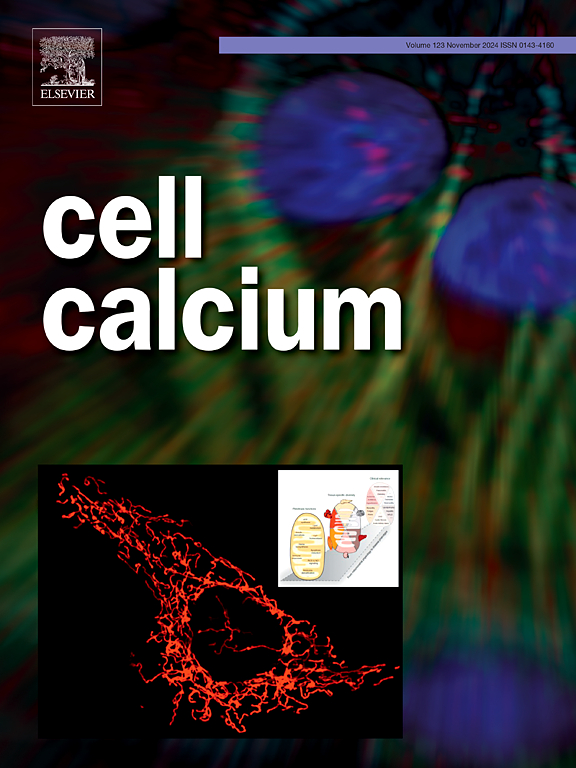Paclitaxel activates SOCE/ICRAC in dorsal root ganglion neurons: implications for paclitaxel-induced peripheral neuropathy
IF 4
2区 生物学
Q2 CELL BIOLOGY
引用次数: 0
Abstract
Paclitaxel (PTX) is one of the most widely used antineoplastic drugs for the treatment of solid cancers. Its mechanism of action involves binding to β-tubulin subunits, leading to the stabilization of microtubule polymers and subsequent cell cycle arrest. Despite its efficacy, PTX is associated with significant adverse effects, most notably peripheral neurotoxicity and neuropathic pain, which represent the primary dose-limiting side effects. In sensory neurons, PTX affects multiple molecular pathways, with early alterations in excitability and calcium signaling following acute drug exposure. To investigate these mechanisms, we employed a combination of calcium imaging, electrophysiological techniques, and pharmacological approaches to explore the role of ORAI channels in the excitability and calcium dynamics of mouse dorsal root ganglion neurons. Our findings reveal that acute exposure to low doses of PTX triggers IP3-dependent calcium release and activates a store-operated calcium entry through STIM-ORAI dependent ICRAC. Moreover, acute PTX application induced the activation of a sustained calcium inward current, Vm depolarization and triggered action potential firing that was strongly attenuated by ICRAC inhibition. Molecular analyses further revealed a significant upregulation of Orai1, Orai2, and Stim2 mRNA levels, accompanied by elevated ORAI1 protein expression, in a rat model of paclitaxel-induced peripheral neuropathy. These results suggest that ORAI and STIM proteins represent promising molecular targets for developing therapies aimed at mitigating the side effects of PTX.

紫杉醇激活背根神经节神经元的SOCE/ICRAC:紫杉醇诱导的周围神经病变的意义
紫杉醇(Paclitaxel, PTX)是目前应用最广泛的治疗实体肿瘤的抗肿瘤药物之一。其作用机制包括与β-微管蛋白亚基结合,导致微管聚合物的稳定和随后的细胞周期阻滞。尽管其疗效良好,但PTX也有明显的不良反应,最明显的是周围神经毒性和神经性疼痛,这是主要的剂量限制性副作用。在感觉神经元中,PTX影响多种分子通路,在急性药物暴露后早期改变兴奋性和钙信号。为了研究这些机制,我们采用钙成像、电生理技术和药理学方法相结合的方法来探索ORAI通道在小鼠背根神经节神经元的兴奋性和钙动力学中的作用。我们的研究结果表明,急性暴露于低剂量的PTX会触发ip3依赖性钙释放,并通过STIM-ORAI依赖性ICRAC激活储存操作的钙进入。此外,急性PTX应用诱导持续钙向内电流的激活,Vm去极化和触发动作电位放电,这被ICRAC抑制强烈减弱。分子分析进一步显示,在紫杉醇诱导的大鼠周围神经病变模型中,Orai1、Orai2和Stim2 mRNA水平显著上调,同时Orai1蛋白表达升高。这些结果表明,ORAI和STIM蛋白是开发旨在减轻PTX副作用的治疗方法的有希望的分子靶点。
本文章由计算机程序翻译,如有差异,请以英文原文为准。
求助全文
约1分钟内获得全文
求助全文
来源期刊

Cell calcium
生物-细胞生物学
CiteScore
8.70
自引率
5.00%
发文量
115
审稿时长
35 days
期刊介绍:
Cell Calcium covers the field of calcium metabolism and signalling in living systems, from aspects including inorganic chemistry, physiology, molecular biology and pathology. Topic themes include:
Roles of calcium in regulating cellular events such as apoptosis, necrosis and organelle remodelling
Influence of calcium regulation in affecting health and disease outcomes
 求助内容:
求助内容: 应助结果提醒方式:
应助结果提醒方式:


